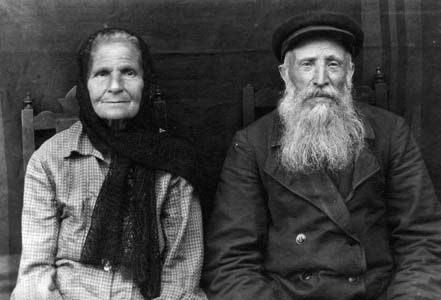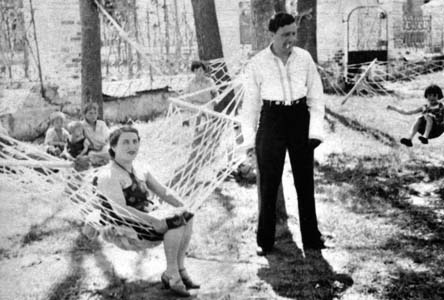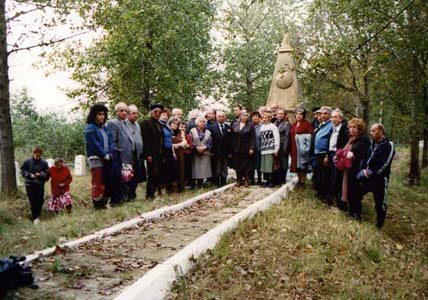

Project «Voices of Jewish settlements. Vitebsk region.»פיתוח קשרי התרבות בין העמים של ישראל ובלרוס
|
|---|
Website search |
|
MainNew publicationsContactsSite mapVitebsk regionMogilev regionMinsk regionArkady Shulman
|
Zoya Lomonosenik’s memories Musia and Shevel Lomonosenik,
Musia and Shevel Lomonosenik,shot in Yanovichi on September 10th 1941. My mother Roda Saulovna Lomonosenik was born in Yanovichi in 1894 (and died in 1957 in Leningrad) in the family of Musia and Shevel Lomonosenik. There were four more children in the family: Isaak, Israel, Zalman and Abram. Before the war Isaak and Israel with their families lived in Yanovichi. Zalman with his family, Abram and I were living in Leningrad. At the beginning of the summer, 1941, Zalman sent his wife and children to Yanovichi. He was mobilized before the war and he was killed near Smolensk in 1943. After the war only three people came out alive of the whole family: Roda, Abram and Zoya Lomonosenik. Mother and Abram did not go to Yanovichi after the war – it would be too much grief for them. I went to Yanovichi in 1987 after Abram’s death. I was told there was a witness of those events in Yanovichi – Yekaterina Nikiforova. It turned out also that she remembered our family.  At the front: wife of one of Musia and Shevel’s son
At the front: wife of one of Musia and Shevel’s sonand Abram, who survived the war. Everyone, except for Abram, was shot by Nazis on September 10th 1941. Before the German invasion many people were preparing to leave the settlement. However, the local doctor literally held their horses saying that he had studied in Germany and was sure that Germans were civilized people and nothing bad would happen. The people believed him and decided to stay. As soon as the Germans arrived they established a ghetto. The ghetto was made of several houses where about 2.000 had to huddle together. Then the people were separated: the men were taken to the closest ditch and shot there. The women and children were taken farther away to the village of Zaitsevo and shot. It happened on September 10th 1941. When the Jews were being taken along the streets of Yanovichi, a man in a horse carriage called a blond Jewish boy – Yekaterina Nikiforova’s son. The boy jumped into the carriage and thus was saved. The man’s last name was Artukhovsky. The boy’s name was Yury. P.S. Before World War II my grandfather’s brother immigrated to the USA. I know my mother received the last letter from him in 1948. It was a dangerous time to write letters abroad, so she burnt the letter. Most probably, our relatives wanted to know how we survived the war. I found out about that letter in the middle of the 80s.  On the grave of the victims, executed
On the grave of the victims, executedon September 10th 1941 in Yanovichi. On the left: Zoya Lomonosenik and Yekaterina Nikiforova. Photo taken at the end of the 80s. I would like to find out if any of our relatives in the United States are alive. I would like to share my memory with them. Their last name is Lomonosov. I will be grateful if you assist me with this. |
|||
|
|
Jewish settlements in Vitebsk regionVitebsk • Albrehtovo • Babinovichi • Baran • Bayevo • Begoml • Beshenkovichi • Bocheikovo • Bogushevsk • Borkovichi • Braslav • Bychiha • Chashniki • Disna • Dobromysli • Dokshitsy • Druya • Dubrovno • Glubokoye • Gorodok • Kamen • Kohanovo • Kolyshki • Kopys • Krasnopolie • Kublichi • Lepel • Liady • Liozno • Lukoml • Luzhki • Lyntupy • Miory • Obol • Oboltsy • Orsha • Osintorf • Ostrovno • Parafianovo • Plissa • Polotsk • Prozorki • Senno • Sharkovshina • Shumilino • Sirotino • Slaveni• Smolyany • Surazh • Tolochin • Ulla • Verhnedvinsk • Vidzy • Volyntsy • Yanovichi • Yezerishe • Zhary • Ziabki • |
Main |
New publications |
Contacts |
Site map |
Vitebsk region |
Mogilev region |
Minsk region |